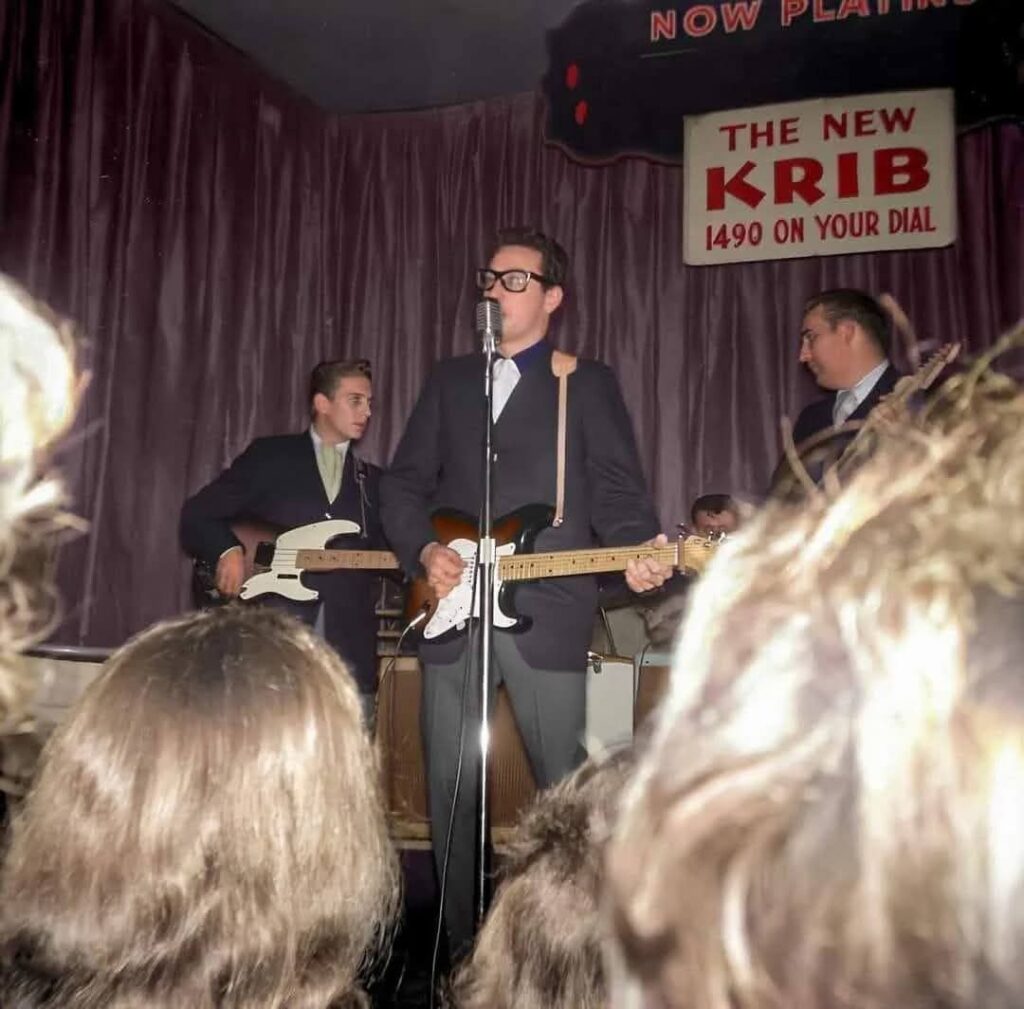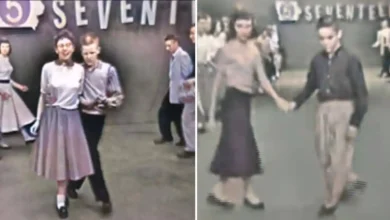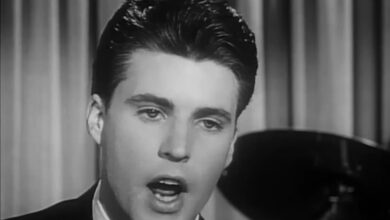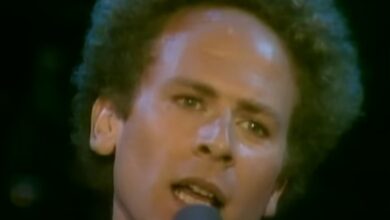Beautiful seeing all three on stage together Richie, Buddy and the big Bopper
In the vibrant tapestry of 1950s rock and roll, few songs have etched themselves into the collective memory as indelibly as Buddy Holly’s “Peggy Sue.” Released in 1957, this track not only showcased Holly’s innovative musicality but also encapsulated the youthful exuberance of the era. Its infectious rhythm and heartfelt lyrics resonated with a generation eager for new sounds, cementing its place in the annals of music history.
The origins of “Peggy Sue” are as intriguing as the song itself. Initially, Holly had titled the composition “Cindy Lou,” in honor of his niece. However, a twist in personal relationships led to a change. Jerry Allison, the drummer for The Crickets, was courting Peggy Sue Gerron at the time. To mend a rift in their relationship, Holly agreed to rename the song “Peggy Sue,” turning it into a melodic olive branch that would forever link Gerron’s name to rock and roll lore.

Recording “Peggy Sue” was a testament to Holly’s dedication to his craft. The sessions took place in Clovis, New Mexico, under the watchful eye of producer Norman Petty. Holly’s meticulous attention to detail was evident as he sought the perfect sound for the track. The result was a song that felt both spontaneous and polished, capturing the raw energy of rock and roll while showcasing Holly’s burgeoning artistry.
Upon its release, “Peggy Sue” quickly climbed the charts, reaching number three on the Billboard Top 100. This success was a clear indicator of Holly’s rising star in the music industry. The song’s appeal was universal, drawing in listeners from all walks of life and solidifying Holly’s reputation as a leading figure in the burgeoning rock and roll movement.
The impact of “Peggy Sue” extended beyond its chart success. It influenced countless musicians and inspired numerous cover versions, each paying homage to Holly’s original while adding their unique twist. Artists across genres found something compelling in the song’s structure and melody, leading to its enduring presence in the musical landscape.
Buddy Holly’s career, though tragically short-lived, was marked by a series of groundbreaking achievements. Born Charles Hardin Holley in Lubbock, Texas, in 1936, he developed a passion for music early on. By his teens, Holly was performing locally, honing the skills that would later captivate audiences worldwide. His distinctive style, characterized by a blend of country, blues, and rock elements, set him apart from his contemporaries.
The formation of The Crickets was a pivotal moment in Holly’s career. Together, they produced hits that have stood the test of time, including “That’ll Be the Day” and, of course, “Peggy Sue.” Their synergy was palpable, with each member contributing to a sound that was both innovative and deeply rooted in the musical traditions of the time.
Tragically, Holly’s meteoric rise was cut short. On February 3, 1959, while en route to a performance, the plane carrying Holly, along with fellow musicians Ritchie Valens and J.P. “The Big Bopper” Richardson, crashed near Clear Lake, Iowa. The accident claimed the lives of all on board, marking a somber day in music history often referred to as “The Day the Music Died.”
Despite his untimely passing at the age of 22, Holly’s influence on the music industry is immeasurable. His innovative approach to songwriting and recording paved the way for future artists, and his work continues to inspire musicians to this day. “Peggy Sue,” in particular, stands as a testament to his talent and vision, a song that encapsulates the spirit of an era while remaining timeless in its appeal.
In the decades since its release, “Peggy Sue” has been featured in numerous films, television shows, and commercials, further cementing its place in popular culture. Its enduring popularity is a testament to Holly’s genius and the song’s universal appeal. Each new generation discovers “Peggy Sue” anew, finding in its melody and lyrics a connection to the past and a source of inspiration for the future.
Reflecting on Buddy Holly’s legacy, it’s clear that his contributions to music extend far beyond his years. “Peggy Sue” is more than just a song; it’s a piece of history, a snapshot of a time when rock and roll was in its infancy, and a young musician from Texas was helping to shape its future. Through his music, Holly lives on, his influence resonating with artists and listeners alike.
In conclusion, “Peggy Sue” remains a shining example of Buddy Holly’s enduring impact on the music world. Its creation, success, and lasting legacy are a testament to his talent and the timeless nature of his work. As we listen to “Peggy Sue” today, we are reminded of a bygone era and the lasting imprint of a true musical pioneer.
On February 3, 1959, the world of music was forever changed by a tragic plane crash near Clear Lake, Iowa. Buddy Holly, Ritchie Valens, J.P. “The Big Bopper” Richardson, and their pilot, Roger Peterson, lost their lives in this fateful accident. The crash occurred shortly after the musicians performed at the Surf Ballroom as part of the “Winter Dance Party” tour, a grueling schedule designed to bring rock and roll to small-town America. This event, marked by its sudden and devastating nature, became a defining moment in music history.
The “Winter Dance Party” tour was marred by brutal winter conditions and an unreliable tour bus, leading to discomfort and illness among the performers. Seeking to avoid the harsh travel conditions, Holly arranged for a small chartered plane to take him and his band to the next stop in Moorhead, Minnesota. Initially, Waylon Jennings, a member of Holly’s band, and guitarist Tommy Allsup were slated to join him. However, Richardson, battling the flu, requested Jennings’ seat, and Valens secured his place after a fateful coin toss with Allsup.
The plane, a Beechcraft Bonanza, departed shortly after midnight, piloted by Roger Peterson, who was not fully certified for instrument-only navigation. Shortly after takeoff, the aircraft encountered deteriorating weather conditions, including snow and poor visibility. Disoriented and unable to navigate in the dark, Peterson lost control of the plane. The aircraft crashed into a frozen cornfield, killing everyone onboard instantly. The tragedy shocked the world and left an indelible mark on the history of rock and roll.
The loss of Buddy Holly, Ritchie Valens, and The Big Bopper at such young ages was a devastating blow to the music industry. Holly, at just 22 years old, had already shaped the sound of rock and roll with his innovative songwriting and influence on future legends like The Beatles. Valens, only 17, was a pioneer of Latin rock with hits like “La Bamba,” while The Big Bopper’s charismatic performances and songs like “Chantilly Lace” had earned him widespread acclaim. Their untimely deaths robbed the world of immense talent and potential.
This tragic event became widely known as “The Day the Music Died,” a term popularized by Don McLean in his 1971 hit song “American Pie.” The phrase encapsulated the sense of loss and the end of an era that the crash represented. Today, the Surf Ballroom in Clear Lake serves as a living memorial to these artists, hosting annual tribute concerts to honor their legacy. The tragedy and its aftermath remain a poignant reminder of the fleeting nature of life and the enduring impact of music.



